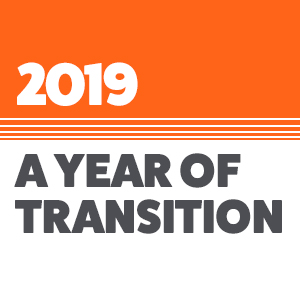The Year in Charts: A Reality Check for Trucking

[Stay on top of transportation news: Get TTNews in your inbox.]
After trucking reached dizzying heights in 2018, the industry reflected more realistic conditions over the past 12 months.
Class 8 sales finished solidly above replacement levels for the first 11 months of 2019; tonnage was up slightly compared with 208's freight volumes, with contract freight holding steady and spot market showing a decline; and trailer orders lagged over freight rates, tariffs and the shape of the economy in general.
Class 8 Sales
U.S. Class 8 retail sales had a very good year, moving above replacement level in every month, adding capacity to an industry in which rates and freight demand were slowing. Through the first 11 months, sales totaled 253,266 — a point that already surpassed all of 2018’s total of 224,508.
Business: Freight Market Slowdown, Tariffs Diminished Trucking Industry's Performance
Government: Hours-of-Service Rule, ELDs and Roads Dominated Political, Regulatory Concerns
Timeline: Trucking's biggest moments
Top 10 stories: A mixed bag of industry news
Charts: Truck sales, trailer orders, tonnage figures
Decade in Review: Looking back at front pages since 2010
The sales trend this year confirmed fleets are slow to back down when the demand cycle softens, after being quick to add trucks earlier to capture more freight in good times, like 2018.
Sales soared to an all-time record of 28,258 in September, led by Freightliner’s sales of 11,654. It is a unit of Daimler Truck North America, which said at the time supply constraints had eased.
However, in November, Class 8 sales fell 12.9% year-over-year, dropping to 18,545 — the lowest point in almost two years. Only Paccar Inc.’s two brands landed in positive territory; all others posted declines in sales compared with the 2018 period.
The latest drop came as truck makers and some key suppliers took steps to cut employees, reduce production levels or related cost-saving measures to address the mounting slowdown in freight demand, which Class 8 sales had masked for much of the year.
This year also marked the entry into the Class 8 market by Hino Motors Manufacturing U.S.A., which had sold eight heavy-duty day cab trucks from its new XL Series launched in October.
Trailer Orders
Trailer makers entered 2019 after pulling in a record 422,351 orders a year earlier. January’s U.S. net orders of nearly 26,000 marked the third consecutive month the backlog increased to record levels. Supply chain issues remained in play, slowing deliveries of components and finished trailers.
“Essentially all production slots are assigned,” Stuart James, chief sales officer at Hyundai Translead, said in March.
Flatbed orders weakened in April as manufacturing slowed.
In May, orders fell to 10,466 — the lowest point in nearly three years. Trailer makers took the drop in stride given the longevity of the current growth cycle — 10 years — and were cautiously optimistic given early indications of 2020 demand even as uncertainty over trade tariffs remained and weaker freight rates year over year.
Trailer orders sunk until October, the beginning of the traditionally strong fourth quarter, when they climbed back up to 31,900. But then in November, they fell to 19,500.
Tonnage
Tonnage was extremely volatile in 2019 as tariffs and the trade war with China caused unusual trade and freight volumes.
American Trucking Associations reported in late November the index was up 3.9% year-to-date when measured against the previous year. ATA’s truck tonnage index is one of the leading indicators of the overall health of the trucking industry. The federation’s monthly indicator is dominated by contract freight, which has remained relatively consistent. However, the spot trucking market has been soft, and economists, including ATA’s Bob Costello, said it’s the main reason why in 2019 the spot market has seen a big dip, after the past two years’ booms are impacting the industry.
“The spot market was growing really strong in 2017 and 2018, and now it’s negative,” Costello said. “When you compare it to the last couple of years, it’s off 50%. This is where the freight recession resides, on the truckload side.”
The Cass Freight Index paints a much less optimistic pitcure about the state of the economy heading into 2020. The October Cass Freight Index fell 5.9% and now has been negative for 11 months in a row.
The report issued a warning for the overall state of the economy.
“We know that freight flows are a leading indicator, so by definition there is a lag between what they are predicting and when the outcome is reported," the report said. "Nevertheless, we see a growing risk that [gross domestic product] will go negative by year’s end. Weakness in commodity prices, and the ongoing decline in interest rates, have all joined the chorus of signals calling for an economic contraction.”
Want more news? Listen to today's daily briefing:


